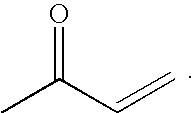Underfill compositions and methods for use thereof
a composition and composition technology, applied in the field of adhesive compositions, can solve the problem of becoming expensive to discard multi-chip packages
- Summary
- Abstract
- Description
- Claims
- Application Information
AI Technical Summary
Problems solved by technology
Method used
Image
Examples
example 1
[0071] The following describes an exemplary synthesis of a polyester linked acrylate or methacrylate according to the invention.
To a 500 mL round bottomed flask was added terephthalic acid (8.31 g, 50 mmol), dicyclopentadiene-dimethanol (23.6 g, 120 mmol), toluene (110 g), and methane sulfonic acid (3.5 g). This mixture was refluxed for 1.5 hours, at which time 2.0 mL of water was collected in a Dean-Stark trap. Next, acrylic acid (7.23 g, 100 mmol) and methacrylic acid (8.62 g, 100 mmol) and an additional 200 mL of toluene were added to the reaction flask. This mixture was refluxed for 2.25 hours, at which time 2.3 mL water had collected in the Dean-Stark trap. This material was then worked up with NaHCO3 (25 g) and 3.5 g water followed by 21 g MgSO4. Once all gas evolution had ceased, the solution was passed through silica gel and the toluene was removed by rotary evaporation, affording the product (Compound 1) (36.6 g, 95% yield).
example 2
[0072]
[0073] To a 500 mL round bottomed flask was added isophthalic acid (8.31 g, 50 mmol), dicyclopentadiene-dimethanol (23.6 g, 120 mmol), toluene (110 g), and methane sulfonic acid (3.5 g). This mixture was refluxed for 1.5 hours, at which time 2.0 mL of water was collected in a Dean-Stark trap. Next, acrylic acid (7.23 g, 100 mmol) and methacrylic acid (8.62 g, 100 mmol) and an additional 200 mL of toluene were added to the reaction flask. This mixture was refluxed for 2.5 hours, at which time 2.3 mL water had collected in the Dean-Stark trap. This material was then worked up with NaHCO3 (25 g) and 3.5 g water followed by 21 g MgSO4. Once all gas evolution had ceased, the solution was passed through silica gel and the toluene was removed by rotary evaporation, affording the product (Compound 2) (36.6 g, 95% yield).
example 3
[0074]
[0075] To a 500 mL round bottomed flask was added the dimmer acid Cognis Empol 1008 (28.27 g, 50 mmol), dicyclopentadiene-dimethanol (23.6 g, 120 mmol), toluene (110 g), and methane sulfonic acid (3.5 g). This mixture was refluxed for 0.5 hours, at which time 2.0 mL of water was collected in a Dean-Stark trap. Next, acrylic acid (7.23 g, 100 mmol) and methacrylic acid (8.62 g, 100 mmol) and an additional 200 mL of toluene were added to the reaction flask. This mixture was refluxed for 2.5 hours, at which time 2.1 mL water had collected in the Dean-Stark trap. This material was then worked up with NaHCO3 (25 g) and 3.5 g water followed by 21 g MgSO4. Once all gas evolution had ceased, the solution was passed through silica gel and the toluene was removed by rotary evaporation, affording the product (Compound 3) (54.6 g, 93% yield).
PUM
| Property | Measurement | Unit |
|---|---|---|
| particle size | aaaaa | aaaaa |
| temperatures | aaaaa | aaaaa |
| temperature | aaaaa | aaaaa |
Abstract
Description
Claims
Application Information
 Login to View More
Login to View More - R&D
- Intellectual Property
- Life Sciences
- Materials
- Tech Scout
- Unparalleled Data Quality
- Higher Quality Content
- 60% Fewer Hallucinations
Browse by: Latest US Patents, China's latest patents, Technical Efficacy Thesaurus, Application Domain, Technology Topic, Popular Technical Reports.
© 2025 PatSnap. All rights reserved.Legal|Privacy policy|Modern Slavery Act Transparency Statement|Sitemap|About US| Contact US: help@patsnap.com



